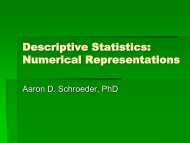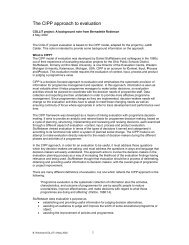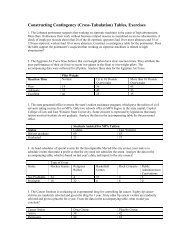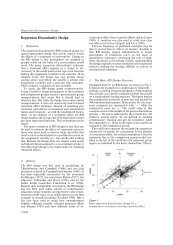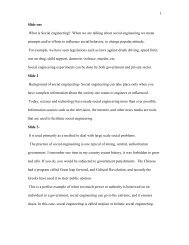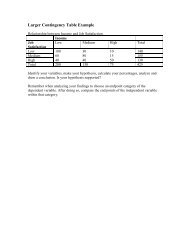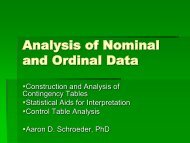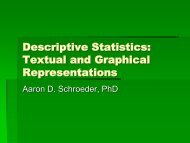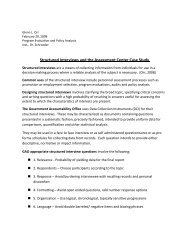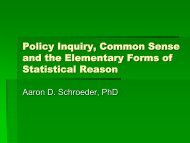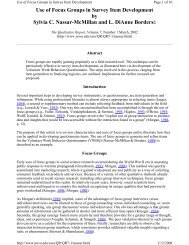Case Study: Logic
Case Study: Logic
Case Study: Logic
You also want an ePaper? Increase the reach of your titles
YUMPU automatically turns print PDFs into web optimized ePapers that Google loves.
<strong>Case</strong> <strong>Study</strong>: <strong>Logic</strong><br />
Konvitz J W 1987 Cartography in France 1660–1848: Science,<br />
Engineering, and Statecraft. University of Chicago Press,<br />
Chicago<br />
Lewis G M 1986 Indicators of unacknowledged assimilations<br />
from Amerindian maps on Euro-American maps of North<br />
America. Imago Mundi 38: 9–34<br />
Lewis G M 1993 Metrics, geometries, signs, and language:<br />
sources of cartographic miscommunication between native<br />
and Euro-American cultures in North America. Cartographica<br />
30(1): 98–106<br />
Lewis G M (ed.) 1998 Cartographic Encounters: Perspecties on<br />
Natie American Mapmaking and Map Use. University of<br />
Chicago Press, Chicago<br />
Lowenthal M A (ed.) 1998 Who’s Who in the History of<br />
Cartography: The International Guide to the Subject (D9).<br />
Map Collector Publications Ltd. for Imago Mundi Ltd.,<br />
Tring, UK<br />
Monmonier M 1989 Maps With The News: The Deelopment of<br />
American Journalistic Cartography. University of Chicago<br />
Press, Chicago<br />
Robinson A H 1982 Early Thematic Mapping in the History of<br />
Cartography. University of Chicago Press, Chicago<br />
Ruggles R I 1991 A Country So Interesting: The Hudson’s Bay<br />
Company and Two Centuries of Mapping, 1670–1870. McGill-<br />
Queen’s University Press, Montreal.<br />
Selin H (ed.) 1997 Encyclopaedia of the History of Science,<br />
Technology, and Medicine in Non-Western Cultures. Kluwer<br />
Academic, Dordrecht, The Netherlands<br />
Skelton R A 1972 Maps: A Historical Surey of Their <strong>Study</strong> and<br />
Collecting. University of Chicago Press, Chicago<br />
Sobel D 1995 Longitude. Walker and Co., New York<br />
Twyman M 1982 The graphic presentation of language. Information<br />
Design Journal 3(1): 1–22<br />
Wallis H M, Robinson A H (eds.) 1987 Cartographic Innoations:<br />
An International Handbook of Mapping Terms to 1900.<br />
Map Collector Publications, Tring, UK in association with<br />
the International Cartographic Association<br />
Wanru C, Xihuang Z, Shengzhang H, Zhongxun N, Jincheng R,<br />
Deyuan J (eds.) 1990 An Atlas of Ancient Maps in China—<br />
From the Warring States Period to the Yuan Dynasty (476<br />
BC–AD 1368). Cultural Relics Publishing House, Beijing<br />
Woodward D 1977 The All-American Map: Wax Engraing and<br />
its Influence on Cartography. University of Chicago Press,<br />
Chicago<br />
Woodward D, Lewis G M (eds.) 1998 The History of CartographyVol.2,book3,CartographyintheTraditional<br />
African,<br />
American, Arctic, Australian, and Pacific Societies. University<br />
of Chicago Press, Chicago<br />
<strong>Case</strong> <strong>Study</strong>: <strong>Logic</strong><br />
1. The <strong>Case</strong> <strong>Study</strong> Defined<br />
G. M. Lewis<br />
The case study is a research strategy with special<br />
implications for theoretical analysis and data collection.<br />
A single case of a particular phenomenon is<br />
examined intensively for the light that it can shed on a<br />
specific problem or question. Often several methods of<br />
data collection will be used to assemble a wide range of<br />
information about the case. One of the main benefits<br />
of a wide-range of data is that it permits a triangulation<br />
of research methods, thus, providing substantial verification<br />
of the particular phenomenon in question.<br />
Researchers vary in why they choose to study a<br />
single case, but most often they do so in order to<br />
examine a proposed theory or to provide grounded<br />
and detailed information for a new theory (Glaser and<br />
Strauss 1967). Although many quantitative researchers<br />
consider the case study as a limited form of<br />
analysis, especially by comparison with methods that<br />
collect information on a large sample of instances,<br />
such a conclusion misconstrues fundamentally the<br />
main purpose of the case study. The analyst who<br />
selects and studies a single case, or even a handful of<br />
cases, is not primarily interested in statistical inference<br />
to a larger population of units, but rather in theoretical<br />
analysis and inference. Nevertheless, the findings from<br />
the study of a single case, like those from the study of<br />
a large sample of instances, always are to be regarded<br />
as tentative, awaiting further confirmation from additional<br />
studies of parallel theoretical cases.<br />
2. Why <strong>Study</strong> the Single <strong>Case</strong>?<br />
The intensive analysis of the case study is premised on<br />
the special advantages that it furnishes. First, the<br />
study of single cases enables the researcher to probe a<br />
particular question, or phenomenon, in great detail.<br />
Such in-depth examinations ultimately permit the<br />
researcher to acquire a degree of knowledge about the<br />
case that is typically impossible through the examination<br />
of a large number of cases. Moreover, such indepth<br />
work also enables the researcher to pursue the<br />
examination of alternative theoretical ideas, thus<br />
ultimately arriving not merely at a thorough understanding<br />
of the empirical facts, but ideally a careful<br />
and correct appreciation of the most germane and<br />
effective theoretical argument to fit these facts (Campbell<br />
1975).<br />
Second, by studying a single case the researcher is<br />
able to take full account of the social, or historical,<br />
context of the phenomenon in question. Students of<br />
case studies regard context as essential to understanding<br />
the nature of the phenomenon. Take, for<br />
example, the study of children who are unruly in the<br />
classroom. The investigator may believe that such<br />
unruliness is the product of how the child relates both<br />
to his peers and teacher in the context of classroom<br />
activity. In order to appreciate and to fully understand<br />
the nature of the child’s reactions, the investigator is<br />
compelled to study the child in the classroom situation<br />
(Stake 1995).<br />
Third, the study of the single case permits the<br />
researchertoprobecomprehensivelyintotheempirical<br />
data at hand. In the study of the workings of a single<br />
community, for example, the case study researcher can<br />
1509
<strong>Case</strong> <strong>Study</strong>: <strong>Logic</strong><br />
explore a variety of dimensions of the community and<br />
can thereby create a multidimensional, or holistic,<br />
sense of the community rather than, let us say, a<br />
unidimensional one based upon its size or territorial<br />
breadth. In so doing the researcher can also emerge<br />
with a fuller understanding of the case in question by<br />
fashioning an integrated portrait of the case into<br />
which the various pieces, or dimensions, fit. Fourth,<br />
the case study provides boundaries to the nature of the<br />
phenomenon under investigation. The case is chosen<br />
because it represents a self-contained unit that will<br />
permit the researcher to investigate the phenomenon<br />
in isolation from other forces. Thus, educational<br />
researchers will often investigate a single classroom or<br />
school because such a case represents some unusual<br />
qualities in which they are interested (Stake 1995).<br />
Finally, the single case is sometimes chosen because<br />
it represents a special illustration of the phenomenon<br />
under investigation. Sometimes it is portrayed as the<br />
exception to the rule, or deviant case, thereby permitting<br />
the observer to understand some more general<br />
phenomenon in greater depth.<br />
3. How to Choose <strong>Case</strong>s<br />
Great care must be exercised in the choice of the single<br />
case. Sometimes social scientists believe that any case<br />
may be used to explore a particular phenomenon.<br />
Indeed, there appears to have been a great deal of<br />
faulty case study research because there are few<br />
guidelines by which to select the case. In fact, the<br />
choice must always involve certain critical decisions in<br />
advance of the data collection and analysis.<br />
First and foremost, the researcher must decide the<br />
grounds for selecting a particular unit for study. Since<br />
such selection is never based upon issues of statistical<br />
inference, the theoretical reasons for selecting the case<br />
must always be made clear—or, at least, as clear as<br />
possible—in advance of the research. For example, the<br />
sociologist R. Stephen Warner believed that broad<br />
societal changes might have a deep influence on the life<br />
of churches in America. Thus, he chose to focus on a<br />
single church, and to examine how the internal<br />
organization of the church changed over several<br />
decades during which there was marked change in<br />
American society. Second, the researcher should<br />
choose those cases that will furnish the clearest tests of<br />
the theory, or argument, in question. If a researcher is<br />
interested in the causes of revolution, then a society<br />
should be chosen where there has been a substantial<br />
and marked revolution, to examine the possible<br />
causes.<br />
3.1 What Qualifies as a <strong>Case</strong>?<br />
Unlike certain forms of research method, such as the<br />
sample survey, case study research can employ very<br />
different units of analysis on which to focus its<br />
theoretical attention. The earliest examples of case<br />
studies were often in-depth studies of particular social<br />
roles, designed to explore the nature of such roles.<br />
Other famous case studies have been done of entire<br />
cities, including the range of different people and<br />
organizations in such cities. More recently, social<br />
researchers have studied specific organizations using<br />
the case study format; specific locales designed to<br />
understand the nature of social groups in those locales;<br />
and even specific indiiduals whose traits exemplify<br />
special qualities for investigation (Stake 1995). In<br />
addition, the case is sometimes used very effectively to<br />
explore in rich detail the nature of social processes at<br />
work. One of the best illustrations of using the case<br />
study in this manner was done by the political scientist,<br />
Matthew Crenson (1971). He furnished a number of<br />
important insights into the nature and exercise of<br />
power, including the dynamics of agenda-setting,<br />
simply from the study of how political decisions were<br />
made in a single city.<br />
4. The <strong>Case</strong> <strong>Study</strong> as a Strategy of Research<br />
By comparison with other research methods, the case<br />
study has certain limitations. It does not permit the<br />
easy and refined manipulation of variables in the same<br />
way as an experiment does. Nor does it permit a<br />
researcher to investigate various configurations of<br />
variables that might be associated with particular<br />
outcomes, or dependent variables, like the sample<br />
survey. Most often, the case study is done using<br />
qualitative methods, thus resulting in some confusion<br />
between case studies and qualitative research (Merriam<br />
1998). Yet there are important examples in which<br />
quantitative data also have been collected to provide<br />
key information about the single case. For example,<br />
some researchers have used time series data on a single<br />
country to examine it in depth.<br />
4.1 The <strong>Case</strong> <strong>Study</strong> as an Inductie Tool<br />
The case study has proven most useful for the<br />
generation of new theory. Because a single case can be<br />
examined in great depth, and because it can be studied<br />
with a variety of research tools, researchers can mine it<br />
for a great deal of information. At the same time, the<br />
careful examination of such information can furnish<br />
insights not easily acquired by other research methods.<br />
Therefore the case study is perhaps at its strongest<br />
when it is used as an inductive research instrument,<br />
allowing the researcher to construct an explanation<br />
for the phenomenon under investigation (Glaser and<br />
Strauss 1967).<br />
4.2 The <strong>Case</strong> <strong>Study</strong> as a Deductie Tool<br />
Yet, the study of the single case can also furnish an<br />
important tool for those observers who wish to test, or<br />
apply, deductive theories. One of the most famous<br />
1510
<strong>Case</strong> <strong>Study</strong>: <strong>Logic</strong><br />
illustrations of this occurs in the classic study of the<br />
InternationalTypographers Union(Lipset etal. 1956).<br />
The authors had concluded, both on empirical and<br />
theoretical grounds, that trade unions were characterized<br />
by very rigid and tightly closed political<br />
administrations, with one clique maintaining its rule in<br />
office over a long period of time. They then chose<br />
deliberately to examine the ITU in detail, because it<br />
appeared to be the exception to the general situation.<br />
What was it about the ITU, they asked, that produced<br />
empirically disparate results from all other trade<br />
unions? This was a powerful, well-refined question. In<br />
effect, the ITU provided a comparison to all other<br />
cases: if its outcome was different, so too must have<br />
been the set of elements that brought about such an<br />
outcome. The answer, furnished through a variety of<br />
evidence, suggested that, because of their level of<br />
education, skill, and commitment to the ITU, union<br />
members of this union, as compared to others, simply<br />
were more likely to take an active role in union affairs.<br />
The one consideration that is overlooked in using<br />
the case study as a deductive tool is that researchers<br />
may fail to specify the nature of the null hypothesis, or<br />
the likely outcome if the theory is incorrect. While<br />
mostcasestudieshavefailedtoconsiderthis important<br />
feature of theory construction and testing, Yin (1994)<br />
argues that, if done carefully, such a strategy can be<br />
incorporated easily into the analysis of single, and<br />
even multiple, cases.<br />
5. The <strong>Case</strong> <strong>Study</strong>: Seminal Illustrations<br />
Over the years there have been a number of very<br />
significant case studies. Two, in particular, illustrate<br />
the wide variety of uses to which case study analysis<br />
can be put in the study of social phenomena.<br />
One of the first, and surely most famous, case<br />
studies was done of the city of Muncie, Indiana (Lynd<br />
and Lynd 1929). Conducted during the course of the<br />
1920s, the investigators and their research team<br />
wanted to uncover the full nature of a typical American<br />
city over the course of its lifetime. Part of their<br />
work involved tracing the history of the city. A large<br />
part, however, involved the collection of a wide range<br />
of information on the city’s current residents, organizations,<br />
and its internal workings.<br />
There were a variety of important discoveries,<br />
including discoveries about the nature of work life and<br />
religious life in the community, as well as about the<br />
dominance of a leading industrial family over the<br />
entirerangeofcivicandpoliticallifeofthecommunity.<br />
It might be noted that sample surveys of city residents,<br />
or demographic data about them, would never have<br />
uncovered the full and complex portrait the Lynds<br />
were able to construct through their pioneering case<br />
study research.<br />
A second famous case study was done of men who<br />
lived in the South End of Boston (Whyte 1943). This<br />
study, also conducted in the 1930s, was ostensibly an<br />
examination of a group of impoverished men, and<br />
how they adapted to life during the Great Depression.<br />
In fact, as Whyte so brilliantly showed, it really was a<br />
case study of a small group of men, and the way in<br />
which the nature of stratification emerged within the<br />
group, and how it influenced the behavior of individuals.<br />
It was done with great insight and care by<br />
Whyte, making it still one of the best and most<br />
influential case studies of all time.<br />
6. Issues of Theoretical Specification: The Use of<br />
Singular <strong>Case</strong>s to Illuminate General Principles<br />
Sometimes the study of the single case is done<br />
specifically to reveal the importance of a special<br />
configuration, or confluence, of elements that together<br />
help to explain the unique outcome of a case, and its<br />
difference from the general pattern (Campbell 1975).<br />
The logic underlying the analyst’s concern is that the<br />
set of variables together constitutes the sufficient,<br />
perhaps even singular, explanation for a particular<br />
outcome, or effect. The research on the International<br />
Typographers Union by Lipset et al. (1956), for<br />
instance, pointed to the special configuration of<br />
conditions in the ITU that helped to promote internal<br />
democracy. It suggested that the special confluence of<br />
factors promoted democracy, leading to the obvious<br />
conclusion that only under certain special social and<br />
historical circumstances could such variables again<br />
come together in such a specific manner.<br />
7. Issues of Theoretical Generalization and<br />
Refinement: The Use of Parallel and Different<br />
<strong>Case</strong>s<br />
Because the analysis of a single case can only take the<br />
analyst so far, the best rule to follow, if possible, is to<br />
examine at least three or four pertinent cases in depth.<br />
Multiple cases permit the researcher to refine and<br />
develop theoretical arguments, and they do so precisely<br />
because case studies permit the researcher to<br />
examine cases deeply and, ultimately, to make careful<br />
comparisons among those cases.<br />
One example will illustrate the advantages of using<br />
several cases and examining them in depth. Orum<br />
(1995) was interested in examining various theories<br />
about the origins of urban growth. Popular theories<br />
had suggested that such growth came about because of<br />
special alliances among the leading figures in different<br />
major institutional spheres, particularly local government,<br />
business, and the media. Orum suggested that<br />
such theories were limited only to contemporary<br />
circumstances and that they did not help much to<br />
explain the sources of growth in the past. Using several<br />
different cases, and studying them in great depth<br />
permitted him to come up with several important<br />
discoveries bearing upon issues of urban growth and<br />
expansion.<br />
1511
<strong>Case</strong> <strong>Study</strong>: <strong>Logic</strong><br />
The first case examined was that of Milwaukee,<br />
Wisconsin. Tracing its origins back to the early<br />
nineteenth century, Orum discovered that the city<br />
seemed to go through certain stages in its growth, and<br />
that one could not simply rely on explanations of<br />
alliances among leaders of different institutional<br />
spheres. Thus, based upon intensive study, he argued<br />
that, in the earliest years, the growth of the city relied<br />
heavily on local entrepreneurs, people who promoted<br />
the city and who, among other things, sold land for it.<br />
But over time this motive force for growth changed,<br />
and the main forces turned to new economic institutions,<br />
ones that brought in growth by attracting new<br />
residents. A third stage happened when the impetus<br />
for growth shifted from the local economic enterprises,<br />
which had grown somewhat stagnant, to local government.<br />
Government sought to expand the community<br />
by adding new territory. Among other things, it also<br />
became clear in this stage that a single conception of<br />
urban growth was inappropriate; growth could take<br />
the form of new population, but also new territory.<br />
Such an insight would have been impossible had Orum<br />
relied only on the study of this single case in depth. The<br />
fourth and final phase happened as the city began to<br />
decline. In large part, the decline took place when<br />
many of its original industries left for greener pastures<br />
in other cities. Under these circumstances, a heavy<br />
burden was placed upon local government to devise<br />
ways to promote growth, either by expanding its<br />
borders or by attracting new industry through various<br />
incentives.<br />
In effect, then, Orum’s explanation for Milwaukee’s<br />
growth suggested that such expansion happened by<br />
stages, and that at each stage there was a different<br />
configuration of local business and political forces<br />
responsible for such growth, and that the principal<br />
form of growth itself could vary between stages. Next,<br />
heaskedwhetherthis patternheldonlyfor Milwaukee,<br />
or whether it could also describe the trajectory of<br />
growth and decline in other parallel industrial cities.<br />
Thus, he made comparisons in the pattern and stages<br />
of growth in Milwaukee with those in Cleveland,<br />
Ohio, a city which, on the face of it, seemed similar in<br />
many respects. In fact, the stages and forces of growth<br />
at each stage were virtually identical in Cleveland and<br />
Milwaukee. He thus argued that among American<br />
industrial cities, the nature of growth, and the forces<br />
responsible for it, showed important parallels, underscoring<br />
his argument on behalf of a stage theory of<br />
urban growth.<br />
Finally, Orum pushed the argument one step further,<br />
wondering whether the pattern found was only<br />
characteristic of industrial growth, and cities, in<br />
America. Could the pattern of stages also apply to<br />
cities that grew up in the postindustrial era and were<br />
themselves postindustrial cities? Here he made a<br />
comparison between the patterns in Milwaukee and<br />
those in Austin, Texas, a postindustrial city he also<br />
had come to know intimately. This comparison<br />
showed that the first three stages were very similar in<br />
terms of the rapidity of growth, and in the role of<br />
entrepreneurs, local business, and local government in<br />
promoting such growth in Milwaukee and Austin<br />
alike. In the end, then, he refined his overall argument<br />
to suggest that the stage view of urban growth in<br />
America fit not only industrial-era cities, but also cities<br />
in the postindustrial era. This suggested that there<br />
appeared to be an underlying structural pattern to the<br />
growth of American cities, regardless of era. This last<br />
comparison also enabled him to draw out differences<br />
between Milwaukee and Austin, allowing for further<br />
understanding of the nature of urban growth, and<br />
difference, in the United States.<br />
In brief, then, as the example of the various cities is<br />
intended to illustrate, the careful and systematic study<br />
of several cases can permit the researcher both to<br />
substantiate important theoretical generalizations and<br />
to refine and extend them. Again, this can be done<br />
because of the deep acquaintance the researcher gains<br />
from the study of cases, an acquaintance unlike that to<br />
be obtained with methods like surveys or experiments.<br />
8. Conclusion<br />
The use of a single case to develop, or to test,<br />
theoretical insights remains a very important strategy<br />
in the social sciences at the start of the twenty-first<br />
century. Indeed, it would appear to be growing in<br />
significance. But it must be executed with great care,<br />
and with a special sensitivity to theoretical issues. The<br />
major limitation in the study of the single case, or even<br />
a handful of cases, lies not in the limited number of<br />
empirical units, but in the ability of the researcher to<br />
be sensitive to issues of theory development and the<br />
gathering of relevant evidence to develop and refine<br />
that theory.<br />
See also: <strong>Case</strong> <strong>Study</strong>: Methods and Analysis; <strong>Case</strong>oriented<br />
Research; Human–Environment Relationship:<br />
Comparative <strong>Case</strong> Studies; Psychotherapy: <strong>Case</strong><br />
<strong>Study</strong>; Single-subject Designs: Methodology; Time<br />
Series: General<br />
Bibliography<br />
Bradshaw Y, Wallace M 1991 Informing generality and explaining<br />
uniqueness: The place of case studies in comparative<br />
research. International Journal of Comparatie Sociology<br />
32(1–2): 154–71<br />
Campbell D T 1975 ‘Degrees of Freedom’ and the case study.<br />
Comparatie Political Studies 8(2): 178–93<br />
Crenson M 1971 The Unpolitics of Air Pollution. Johns Hopkins<br />
Press, Baltimore, MD<br />
Feagin J R, Orum A M, Sjoberg G (eds.) 1991 A <strong>Case</strong> for the<br />
<strong>Case</strong> <strong>Study</strong>. University of North Carolina Press, Chapel Hill,<br />
NC<br />
1512
<strong>Case</strong> <strong>Study</strong>: Methods and Analysis<br />
Glaser B G, Strauss A L 1967 The Discoery of Grounded<br />
Theory: Strategies for Qualitatie Research. Aldine, Chicago<br />
Lipset S M, Trow M, Coleman J S 1956 Union Democracy: the<br />
Internal Politics of the International Typographical Union.<br />
Free Press, Glencoe, IL<br />
Lynd R, Lynd H M 1929 Middletown: A <strong>Study</strong> in American<br />
Culture. Harcourt Brace, New York<br />
Merriam S B 1998 Qualitatie Research and <strong>Case</strong> <strong>Study</strong> Applications<br />
in Education. Jossey-Bass, San Francisco<br />
Orum A M 1995 City-Building in America. Westview Press,<br />
Boulder, CO<br />
Ragin C C, Becker H S (eds.) 1992 What Is A <strong>Case</strong>? Exploring<br />
the Foundations of Social Inquiry. Cambridge University Press,<br />
Cambridge, UK<br />
Ragin C, Zaret D 1983 Theory and method in comparative<br />
research: Two strategies. Social Forces 61(3): 731–54<br />
Stake R E 1995 The Art of <strong>Case</strong> <strong>Study</strong> Research. Sage, Thousand<br />
Oaks, CA<br />
Warner R S 1991 Oenology: The making of New Wine. In:<br />
Feagin J R, Orum A M, Sjoberg G (eds.) A <strong>Case</strong> for the <strong>Case</strong><br />
<strong>Study</strong>. University of North Carolina Press, Chapel Hill, NC,<br />
pp. 174–99<br />
Whyte W F 1943 Street Corner Society: The Social Structure of<br />
an Italian Slum. University of Chicago Press, Chicago<br />
Yin R K 1994 <strong>Case</strong> <strong>Study</strong> Research: Design and Methods, 2nd<br />
edn. Sage, Thousand Oaks, CA<br />
<strong>Case</strong> <strong>Study</strong>: Methods and Analysis<br />
A. M. Orum<br />
<strong>Case</strong> study methods have been around as long as<br />
recorded history, and they presently account for a<br />
large proportion of the books and articles in anthropology,<br />
biology, economics, history, political science,<br />
psychology, sociology, and even the medical sciences.<br />
The logic of case study methods, much like that of any<br />
historian’s or detective’s efforts to make inferences<br />
from patterns within cases and comparisons between<br />
them, is more intuitive than the logic of statistical<br />
inference. Until relatively recently, however, the lack<br />
of formalization of the logic of case study methods<br />
inhibited them achieving their full potential for contributing<br />
to the progressive and cumulative development<br />
of theories. It is only in the last three decades<br />
that scholars have formalized case study methods and<br />
linkedthemtounderlyingargumentsinthe philosophy<br />
of science. Ironically, statistical methods, though less<br />
intuitive, were standardized earlier, so that attempts to<br />
formalize case study methods often misappropriated<br />
terms and concepts from statistics (McKeown 1999).<br />
More recently, case study methods have evolved from<br />
being defined ‘negatively,’ via contrasts to statistical<br />
methods, to being defined ‘positively,’ by their distinctive<br />
logic, techniques, and comparative advantages.<br />
This continuing evolution remains a contested<br />
process, but there is growing consensus on the proper<br />
procedures for carrying out case studies and the<br />
strengths and limits of such studies. It is becoming<br />
increasingly clear through this process that the comparative<br />
advantages of case study and statistical<br />
methods are largely complementary and that the two<br />
methods can thus achieve far more scientific progress<br />
together than either could alone.<br />
1. The Definition of ‘<strong>Case</strong>’ and ‘<strong>Case</strong> <strong>Study</strong>’<br />
Early efforts to define ‘case studies’ relied on distinctions<br />
between the study of a small vs. a large number<br />
of instances of a phenomenon. <strong>Case</strong> studies thus<br />
became characterized as ‘small n’ studies, in contrast<br />
to ‘large N’ statistical studies. Related to this, one<br />
early definition stated that a ‘case’ is a ‘phenomenon<br />
for which we report and interpret only a single measure<br />
on any pertinent variable’ (Eckstein 1975). <strong>Case</strong> study<br />
researchers have increasingly rejected this definition,<br />
however, because it wrongly implies, in the language<br />
of statistics, that there is an inherent ‘degrees of<br />
freedom’ problem in case studies. In other words, this<br />
definition of case studies suggests that with a greater<br />
number of variables than observations on the dependent<br />
variable, case studies provided no basis for<br />
causal inference. In the view of case study researchers,<br />
however, each case includes a potentially large number<br />
of observations on intervening variables and qualitative<br />
measures of different aspects of the dependent<br />
variable, so there is not just a ‘single measure’ of the<br />
variables or an inherent degrees of freedom problem.<br />
This point is increasingly recognized by researchers<br />
from the statistical tradition (King et al. 1994).<br />
In addition, the ‘small nlarge N’ distinction implies<br />
that large N methods are always preferable whenever<br />
sufficient data is available. As argued below, however,<br />
case studies can serve useful theory building purposes,<br />
such as the inductive generation of new hypotheses,<br />
even when instances of a phenomenon are sufficiently<br />
numerous to allow the application of statistical<br />
methods.<br />
For present purposes, then, a case is defined as an<br />
instance of a class of eents (George 1979a, 1979b).<br />
The term ‘class of events’ refers here to a phenomenon<br />
of scientific interest, such as revolutions, types of<br />
governmental regime, kinds of economic system, or<br />
personality types. A case study is thus a well-defined<br />
aspect of a historical happening that the inestigator<br />
selects for analysis, rather than a historical happening<br />
itself. The Cuban Missile Crisis, for example, is a<br />
historical instance of many different classes of events:<br />
cases of deterrence, coercive diplomacy, crisis management,<br />
and so on. In deciding which class of events<br />
to study and which theories to use, the researcher<br />
decides what data from the Cuban Missile Crisis is<br />
relevant to their case study of it. Of course, even if one<br />
accepts the present definition of a case, there is still<br />
room in the context of particular studies to debate<br />
such questions as: ‘what is this event a case of’ and<br />
‘given this phenomenon, is this event a case of it?’<br />
(Ragin and Becker 1992).<br />
1513
<strong>Case</strong> <strong>Study</strong>: Methods and Analysis<br />
There is potential for confusion among the terms<br />
‘comparative methods,’ ‘case study methods,’ and<br />
‘qualitative methods.’ In one view the comparative<br />
method, or the use of comparisons among a small<br />
number of cases, is distinct from the case study<br />
method, which in this view involves the internal<br />
examination of single cases (see Comparatie Studies:<br />
Method and Design). For the present purposes, however,<br />
case study methods are defined to include both<br />
within-case analysis of single cases and comparisons<br />
between or among a small number of cases. This is not<br />
an effort to claim wider meaning for the term ‘case<br />
studies,’ but an outgrowth of the growing consensus<br />
that the strongest means of drawing inferences from<br />
case studies is the use of a combination of within-case<br />
analysis and cross-case comparisons within a single<br />
study or research program, although single case<br />
studies can also play a role in theory development. As<br />
for the term ‘qualitative methods,’ this is sometimes<br />
used to encompass both case studies carried out with a<br />
positivist view of the philosophy of science and those<br />
implemented with a postmodern or interpretive view.<br />
Thispresentarticlehewstothetraditionalterminology<br />
in focusing on ‘case studies’ as that subset of qualitative<br />
methods that has adopted a largely positivist<br />
framework.<br />
2. The Historical Deelopment of <strong>Case</strong> <strong>Study</strong><br />
Methods<br />
<strong>Case</strong> study methods have developed through several<br />
phases over the last three decades. Prior to the 1970s,<br />
‘case studies’ consisted primarily of historical studies<br />
of particular events, countries, or phenomena, with<br />
littleeffort to cumulateresults or progressively develop<br />
theories (Verba 1967). Throughout the 1970s, however,<br />
scholars who were dissatisfied with the state of<br />
case study methods, and encouraged by the example of<br />
the formalization of statistical methods, began to<br />
formalize case study methods.<br />
First, Adam Przeworski and Henry Teune (1970)<br />
clarified the logic of ‘most similar’ and ‘least similar’<br />
case comparisons. In the former comparison, which<br />
draws on the logic of John Stuart Mill’s method of<br />
difference and mimics the experimental method, the<br />
researcher compares two cases that are similar in all<br />
but one independent variable and that differ in the<br />
outcome variable. Such a comparison may be consistent<br />
with the inference that the difference in the<br />
single independent variable that varies between the<br />
cases accounts for the difference in the dependent<br />
variable (although for a variety of reasons discussed<br />
below, this inference may be spurious). In a comparison<br />
of least similar cases, which draws on Mill’s<br />
method of agreement, the researcher compares two<br />
cases that differ in all but one independent variable but<br />
that have the same value on the dependent variable. If,<br />
Table 1<br />
Types of case studies<br />
Lijphart<br />
Eckstein<br />
atheoretical configurative-ideographic<br />
interpretative disciplined-configurative<br />
hypothesis generating heuristic<br />
deviant ?<br />
theory-confirming<br />
infirming<br />
crucial, most-likely,<br />
least-likely<br />
for example, we find that teenagers are ‘difficult’ in<br />
both tribal societies and industrialized societies, we<br />
might be tempted to infer that it is the nature of<br />
teenagers rather than the nature of society that<br />
accounts for the difficulty of teenagers.<br />
Arend Lijphart (1971) and Harry Eckstein (1975)<br />
contributed further to the formalization of case study<br />
methods by clarifying the differences among various<br />
types of case study research designs and theorybuilding<br />
goals. These authors identified similar types,<br />
although their terminology differs and Lijphart adds<br />
an important type, the ‘deviant case,’ for which<br />
Eckstein does not make explicit provision. Their types<br />
of case studies correspond as shown in Table 1.<br />
The atheoretical or configurative-ideographic case<br />
study takes the form of a detailed narrative or ‘story’<br />
presented in the form of a chronicle that purports to<br />
illuminate how an event came about. Such a narrative<br />
is highly specific and makes no explicit use of theory or<br />
theory-related variables. Most case studies, however,<br />
do have an explanatory purpose. These studies generally<br />
fall into the category of ‘disciplined-configurative’<br />
or ‘interpretive’ case studies, in which general<br />
propositions are used, often implicitly, to explain<br />
specific historical cases. Another variant of such case<br />
studies is the use of cases as examples that illustrate a<br />
theory.<br />
Heuristic case studies seek to generate new hypotheses<br />
inductively from the study of particular cases.<br />
Notably, statistical methods lack this capacity for<br />
inductively generating hypotheses, and they typically<br />
rely instead on hypotheses derived deductively or<br />
borrowed from case study research. An especially<br />
important type of case study for developing new<br />
hypotheses is the ‘deviant’ case study. This is the study<br />
of a case whose outcome is not predicted or explained<br />
adequately by existing theories. Unless the outcome of<br />
a deviant case turns out to be a consequence of<br />
measurement error, the case is likely to be useful for<br />
identifying variables that have been left out of existing<br />
theories. Finally, researchers can use case studies to<br />
test whether the outcomes and processes that theories<br />
predict in particular cases are in fact evident.<br />
Eckstein’s and Lijphart’s contributions demonstrated<br />
that there was not just a single type of case<br />
study, but many kinds of case study research designs<br />
and many different theory-building purposes that they<br />
1514
<strong>Case</strong> <strong>Study</strong>: Methods and Analysis<br />
could serve. Their treatments differed, however, in<br />
that Lijphart relied greatly on statistical concepts and<br />
language. He was thus skeptical of the value of single<br />
case studies for building social science theories, and,<br />
consistent with the widespread preference at the time<br />
for ‘large N’ over ‘small n’ methods, he urged researchers<br />
to consider several means of either decreasing<br />
the number of variables in their models or<br />
increasing the number of cases to be studied in order to<br />
make use of statistical rather than case study methods.<br />
This advice, however, raised the risk ‘conceptual<br />
stretching’ (Sartori 1970), or of lumping together<br />
dissimilar cases under the same definitions. Possibly<br />
for this reason, Lijphart later placed greater emphasis<br />
instead on the controlled comparison of most similar<br />
to cases as a basis for causal inference (Lijphart 1975,<br />
Collier 1993).<br />
Eckstein, in contrast, focused on the use of case<br />
studies for theory testing and argued that even single<br />
case studies could provide tests that might strongly<br />
support or impugn theories. In so doing, Eckstein<br />
developed the idea of a ‘crucial case,’ or a case that<br />
‘must closely fit a theory if one is to have confidence in<br />
thetheory’svalidity,or,conversely,mustnotfitequally<br />
well any rule contrary to that proposed’ (Eckstein<br />
1975, his emphasis). Eckstein argued that true crucial<br />
cases are rare, so he pointed to the alternative of ‘most<br />
likely’ and ‘least likely’ cases. A most likely case is one<br />
that is almost certain to fit a theory if the theory is true<br />
for any cases at all. The failure of a theory to explain<br />
a most likely case greatly undermines our confidence<br />
in the theory. A least likely case, conversely, is a tough<br />
test for a theory because it is a case in which the theory<br />
makes only a weak prediction. A theory’s ability to<br />
explain a least likely case is strong evidence in favor of<br />
the theory. In this way, Eckstein argued, even single<br />
case studies could greatly increase or decrease our<br />
confidence in a theory or require that we alter its scope<br />
conditions.<br />
Alexander George (1979a, 1979b) further developed<br />
case study methods by refining ‘within-case’<br />
analysis and cross-case comparisons in ways that help<br />
each method compensate for the limits of the other.<br />
George argued, as Mill himself had, that the ‘method<br />
of difference’ and the corresponding practice of comparison<br />
of most similar cases could lead to spurious<br />
inferences. One reason for this is that no two nonexperimental<br />
cases achieve the ideal of being similar in<br />
all respects but one independent variable and the<br />
outcome. Thus, there is always the danger that left-out<br />
variables or residual differences in the values of the<br />
independent variables account for the difference in<br />
the outcomes of similar cases of (see Human–<br />
Enironment Relationship: Comparatie <strong>Case</strong> Studies).<br />
In addition, as Mill recognized, phenomena might be<br />
characterized by what general systems theorists have<br />
termed ‘equifinality,’ or the condition in which the<br />
same outcome can arise through different causal<br />
pathways or combinations of variables. Thus, there<br />
might be no single necessary or sufficient variable for a<br />
phenomenon: it might be that either ABC or DEF<br />
causes Y, and that none of the variables A–F is itself<br />
sufficient to cause Y (see Human–Enironment Relationship:<br />
Comparatie <strong>Case</strong> Studies). In such circumstances,<br />
pair-wise comparisons of cases might wrongly<br />
reject variables that contribute to the outcome of<br />
interest in conjunction with some contexts but not<br />
with others, and might also accept as causal variables<br />
that are in fact spurious.<br />
To compensate for these limits of controlled comparison,<br />
George developed the ‘within case’ methods<br />
of ‘congruence testing’ and ‘process tracing’ as means<br />
of checking on whether inferences arrived at through<br />
case comparisons were spurious (see Pattern Matching:<br />
Methodology). In congruence testing, the researcher<br />
checks whether the prediction a theory makes<br />
in a case, in view of the values of the case’s independent<br />
variables, is congruent with the actual outcome in the<br />
case. In process tracing, the researcher examines<br />
whether the causal process a theory hypothesizes in a<br />
case is in fact evident in the sequence and values of the<br />
intervening variables in that case. Thus, process<br />
tracing might be used to test whether the residual<br />
differences between two similar cases were causal or<br />
spurious in producing a difference in these cases’<br />
outcomes. Process tracing can perform a heuristic<br />
function as well, generating new variables or hypotheses<br />
on the basis of sequences of events observed<br />
inductively in cases.<br />
George (1979a, 1979b) also systematized case study<br />
procedures by developing what he called the method<br />
of ‘structured focused comparison.’ In this method,<br />
the researcher systematically: (a) specifies the research<br />
problem and the class of events to be studied; (b)<br />
defines the independent, dependent, and intervening<br />
variables of the relevant theories; (c) selects the cases<br />
to be studied and compared; (d) decides how best to<br />
characterize variance in the independent and dependent<br />
variables; and (e) formulates a detailed set of<br />
standard questions to be applied to each case. In<br />
addition, consistent with his emphasis on equifinality,<br />
George argued that case studies could be especially<br />
useful in developing what he called ‘typological<br />
theories,’ or contingent generalizations on ‘the ariety<br />
of different causal patterns that can occur for the<br />
phenomena in question … [and] the conditions under<br />
which each distinctie type of causal patterns occurs’<br />
(George 1979a, his emphasis). He thus advocated a<br />
kind of ‘building block’ approach to the development<br />
of theories in which each case, while rendered in terms<br />
of theoretical variables, might prove to be a distinctive<br />
causal pathway to the outcome of interest.<br />
In the 1980s and 1990s, thousands of books and<br />
articles made use of these improvements in case study<br />
methods in a wide variety of social science research<br />
programs.Meanwhile,scholarscontinuedto elaborate<br />
case study methods and articulate the ways in which<br />
they differed from statistical methods. David Collier,<br />
1515
<strong>Case</strong> <strong>Study</strong>: Methods and Analysis<br />
reviewing the development of case study and comparative<br />
methods, argued that these methods have<br />
advantages in defining and measuring qualitative<br />
variables in conceptually valid ways and forestalling<br />
the problem of conceptual stretching (Collier<br />
1993). Charles Ragin argued that qualitative methods<br />
were also better than statistical methods at accounting<br />
for equifinality and complex interaction effects. Although<br />
statistical methods can model several kinds of<br />
interaction effects, Ragin noted, they can do so only at<br />
the cost of requiring a larger sample size, and models<br />
of nonlinear interactions rapidly become complex and<br />
difficulttointerpret.Raginalsointroducedthe method<br />
of Qualitative Comparative Analysis, which uses<br />
Boolean algebra to reduce a series of comparisons of<br />
cases to the minimum number of logical statements or<br />
hypotheses that entail the results of all the cases<br />
compared (Ragin 1987). This method, he argues,<br />
makes comparisons among cases in ways that treat<br />
them inherently as configurations of variables, and<br />
that thus allow for the possibility of equifinality and<br />
complex interactions (see Configurational Analysis).<br />
Both Collier and Ragin also noted the limitations of<br />
case study methods, including the potential for indeterminacy<br />
when attempting to sort out rival explanations<br />
in a small number of cases, the difficulty of<br />
attaining a detailed understanding of more than a few<br />
cases, and the inability to make broad generalizations<br />
on the basis of small numbers of cases.<br />
3. New Deelopments in <strong>Case</strong> <strong>Study</strong> Methods<br />
The thousands of applications of case study methods<br />
in the last two decades have provided fertile ground<br />
for further methodological refinements. Three key<br />
recent developments include the strengthening of<br />
linkages between case study methods and the philosophy<br />
of science, the elaboration of the concept of<br />
typological theories, and the emergence of elements of<br />
consensus on the comparative advantages and limitations<br />
of case study methods.<br />
3.1 <strong>Case</strong> Studies and the Philosophy of Science<br />
With regard to the philosophy of science, the ‘scientific<br />
realist’ school of thought has emphasized that causal<br />
mechanisms, or independent stable factors that under<br />
certain conditions link causes to effects, are important<br />
to causal explanation (Little 1998). This has resonated<br />
with case study researchers’ use of process tracing to<br />
uncover evidence of causal mechanisms at work. It has<br />
also provided a philosophical counterpoint to attempts<br />
by researchers from the statistical tradition to<br />
place ‘causal effects,’ or the expected difference in<br />
outcomes brought about by the change in a single<br />
independent variable, at the center of causal explanation<br />
(King et al. 1994). <strong>Case</strong> study researchers<br />
have argued that both causal mechanisms, which are<br />
more easily addressed by case studies, and causal<br />
effects, which are best assessed through statistical<br />
means, are essential to the development of causal<br />
theories and causal explanations (George and Bennett<br />
2001).<br />
Another relevant development in the philosophy of<br />
science has been the resurgence of interest in Bayesian<br />
logic, or the logic of using new data to update prior<br />
confidence levels assigned to hypotheses. Bayesian<br />
logic differs from that of most statistics, which eschew<br />
reliance on prior probabilities. Eckstein’s crucial, most<br />
likely, and least likely case study designs implicitly use<br />
a Bayesian logic, assigning prior probabilities to the<br />
likelihood of particular outcomes (McKeown 1999).<br />
One new development here is the refinement of<br />
Eckstein’s approach, taking into consideration the<br />
likelihood of an outcome not just in view of one<br />
theory, but in the presence of alternative hypotheses.<br />
If a case is ‘most likely’ for a theory, and if the<br />
alternative hypotheses make the same prediction, then<br />
the theory will be strongly impugned if the prediction<br />
does not prove true. The failure of the theory cannot<br />
be blamed on the influence of the variables highlighted<br />
by the alternative hypotheses. Conversely, if a theory<br />
makes only a weak prediction in a ‘least likely’ case,<br />
the alternative hypotheses make a different prediction,<br />
but if the first theory’s prediction proves true, this is<br />
the strongest possible evidence in favor of the theory<br />
(Van Evera 1997). This helps address the central<br />
problemofaBayesianapproach—thatofassigningand<br />
justifying prior probabilities—even if it does not fully<br />
resolve it.<br />
The continuing development of the logic of hypothesis<br />
testing has also been relevant to case study<br />
methods (see Hypothesis Testing: Methodology and<br />
Limitations). On this topic, Imre Lakatos argued that<br />
a theory can be considered progressive only if it<br />
predicts and later corroborates ‘new facts,’ or novel<br />
empirical content not anticipated by other theories<br />
(Lakatos 1976). This criterion helps provide a standard<br />
for judging whether process tracing, the designation<br />
of new subtypes, and the proposal of new<br />
theories from heuristic case studies are being done in a<br />
progressive or regressive way. It also provides a<br />
philosophical basis for arguing that a hypothesis can<br />
be derived from one set of observations within a case<br />
and then to some extent tested against the ‘new facts’<br />
or previously unexamined or unexpected data that it<br />
predicts within that same case, although independent<br />
corroboration in other cases is usually advisable as<br />
well (Collier 1993).<br />
3.2 Typological Theories and ‘Fuzzy <strong>Logic</strong>’<br />
A second recent development in case study methods<br />
has been the elaboration of the concept of typological<br />
theory. Typological theories occupy a middle ground<br />
between covering laws, or highly general abstract<br />
propositions, and causal mechanisms. Typological<br />
1516
<strong>Case</strong> <strong>Study</strong>: Methods and Analysis<br />
theories identify recurring conjunctions of mechanisms<br />
and provide hypotheses on the pathways through<br />
which they produce effects. Thus, like QCA, typological<br />
theories treat cases as configurations. Unlike<br />
QCA, they do not attempt to reduce the number of<br />
theoretical statements about the variables, but retain a<br />
diverse and admittedly complex set of contingent<br />
generalizations, with potentially one generalization<br />
per type. Consequently, typological theories are well<br />
suited to modeling equifinality.<br />
To construct typological theories, researchers first<br />
specify the variables and use them to define the<br />
typological space, or the set of all mathematically<br />
possible combinations of the variables (this is sometimestermedatruthtableinthephilosophyofscience).<br />
At first this may seem to produce an unmanageably<br />
large number of combinations: a model with five<br />
dichotomous variables, for example, would have 32<br />
possible types. However, once the researcher begins to<br />
categorize extant cases in a preliminary way into<br />
particular types, it often becomes possible to narrow<br />
the range of cases of interest for study. Many types<br />
may remain empty, with no extant cases. Some types<br />
may be overdetermined for the outcome of interest,<br />
and hence not worthy of study unless they have an<br />
unexpected outcome. From among the cases and types<br />
that remain, the researcher can use the preliminary<br />
categorization of cases within the typological space to<br />
help identify most likely, least likely, most similar,<br />
least similar, and crucial cases for study. <strong>Case</strong>s in the<br />
typological space with unexpected outcomes, or deviant<br />
cases, can help identify new causal pathways that<br />
can be added to the existing theory in a kind of<br />
‘building block’ approach (George and Bennett<br />
2001). A related development concerns the concept of<br />
‘fuzzy logic’ (Ragin 2000). Fuzzy logic treats cases as<br />
configurations but rather than using dichotomous or<br />
trichotomous variables and categorizations of cases, it<br />
allows the use of scaling to give a score on the extent to<br />
which a case fits into a certain type. In other respects,<br />
the use of fuzzy logic proceeds in ways much like those<br />
of typological theories.<br />
3.3 The Emerging Consensus on the Strengths and<br />
Limits of <strong>Case</strong> <strong>Study</strong> Methods<br />
A third development is that while several debates on<br />
case study methods continue, others have moved<br />
toward synthesis or even closure, and the overall<br />
picture is of an emerging consensus on the advantages<br />
limitations of case study methods. As noted above,<br />
researchers from a variety of methodological traditions<br />
have recognized that because case studies can<br />
include many observations, they do not suffer from an<br />
inherent degrees of freedom problem. At the same<br />
time, it is also widely agreed that particular case<br />
studies may suffer from indeterminacy, or an inability<br />
to exclude all but one explanation on the basis of<br />
available process tracing evidence (Njolstad 1990).<br />
When this occurs, it may still be possible to narrow the<br />
number of plausible explanations, and it is also<br />
important to indicate as clearly as possible the extent<br />
to which the remaining hypotheses appear to be<br />
complementary, competing, and incommensurate in<br />
explaining the case.<br />
Second, most case study researchers have readily<br />
acknowledged the limits of Mill’s methods. Ragin’s<br />
alternative of qualitative comparative analysis makes<br />
less restrictive assumptions, but its results are highly<br />
sensitive to changes in the measurement or coding of a<br />
single case (Goldthorpe 1997). There has thus been a<br />
movementtowardtypologicaltheoriesandfuzzylogic,<br />
which make still less restrictive assumptions than QCA<br />
and are not so sensitive to the results of a single case.<br />
In addition, there is growing consensus that the use of<br />
within-case methods of analysis helps provide a check<br />
on the potential spuriousness of cross-case comparisons<br />
(Collier 1993, Mahoney 1999, George and<br />
Bennett 2001). <strong>Case</strong> study researchers consequently<br />
seldom if ever rely on case comparisons alone.<br />
Third, there is growing recognition that the case<br />
selection criteria necessary for statistical studies are in<br />
some respects inappropriate for case studies. Random<br />
selection in a case study research design, for example,<br />
can result in worse biases than intentional selection<br />
(King et al. 1994). There is also increasing understanding<br />
that, consistent with the reliance of some case<br />
study designs on a Bayesian logic, case studies are<br />
sometimes intentionally selected not to be representative<br />
of some wide population but to provide the<br />
strongest possible inferences on particular theories<br />
(McKeown 1999). There is still disagreement between<br />
those who warn against any selection on the dependent<br />
variable (King et al. 1994) and those who argue<br />
that selection on the dependent variable is appropriate<br />
for some research objectives (Collier and Mahoney<br />
1996, Ragin 2000, George and Bennett 2001). Related<br />
to this is a continuing disagreement over whether<br />
single case studies can make only limited contributions<br />
to theory building (King et al. 1994), or whether<br />
single case studies have indeed reshaped entire research<br />
programs (Rogowski 1995). There is wider<br />
agreement, however, that selection bias is potentially<br />
more severe in case studies than statistical studies<br />
because biased selection of case studies can overstate<br />
as well as understate the relationship between the<br />
independent and dependent variables (Collier and<br />
Mahoney 1996).<br />
On the whole discussions of these issues have<br />
moved toward an emerging consensus on the comparative<br />
advantages and limitations of case study<br />
methods. These methods’ advantages include the<br />
conceptualization, operationalization, and measurement<br />
of qualitative variables (conceptual validity), the<br />
avoidance of conceptual stretching, the heuristic identification<br />
of new variables and hypotheses (often<br />
through study of deviant cases), the assessment of<br />
1517
<strong>Case</strong> <strong>Study</strong>: Methods and Analysis<br />
whether statistical generalizations offer plausible or<br />
spurious explanations of individual cases, the incorporation<br />
of equifinality and complex interactions<br />
effects, and the inferences made possible by combining<br />
within-case and cross-case analyses (Collier 1993,<br />
Munck 1998, George and Bennett 2001). It is possible<br />
that new statistical methods may be able to improve<br />
upon the statistical treatment of equifinality and<br />
interaction effects, and at least narrow the gap in the<br />
treatment of this issue, but the other comparative<br />
advantages of case study methods appear to be<br />
inherent in their differences from statistical methods.<br />
The limits of case study methods include their<br />
inappropriateness for judging the relative frequency or<br />
representativeness of cases, their weakness at performing<br />
partial correlations and establishing causal<br />
effects or causal weight, the necessarily narrow and<br />
contingent nature of their generalizations, and the<br />
danger that selection bias can be more catastrophic<br />
than in statistical studies (Collier 1993, King et al.<br />
1994, Munck 1998, George and Bennett 2001). Fortunately,<br />
these are precisely the strengths of statistical<br />
studies.<br />
4. Future Directions in <strong>Case</strong> <strong>Study</strong> Methods<br />
Just as the formalization of case study methods in the<br />
1970s inspired a generation of more sophisticated<br />
research, the recent further refinements in these<br />
methods are likely to lead to still greater sophistication<br />
in their use in the social, biological, and even physical<br />
sciences. The increasingly evident complementarity of<br />
case study and statistical methods is likely to lead<br />
toward more collaborative work by scholars using<br />
various methods. The recent interest among rational<br />
choice theorists in using case studies to test their<br />
theories, for example, is an important step in this<br />
direction (Bates et al. 1998). Because case studies,<br />
statistical methods, and formal modeling are all<br />
increasingly sophisticated, however, it is becoming less<br />
likely that a single researcher can be adept at more<br />
than one set of methods while also attaining a cuttingedge<br />
theoretical and empirical knowledge of their<br />
field. Collaboration might therefore take the form of<br />
several researchers working together using different<br />
methods, or of researchers more self-consciously<br />
building on the findings generated by those using<br />
different methods. In either form, effective collaboration<br />
requires that even as they become expert in<br />
one methodological approach, scholars must also<br />
becomeconversantwithalternativeapproaches,aware<br />
of their strengths and limits, and capable of an<br />
informed reading of their substantive results.<br />
See also: Biographical Methodology: Psychological<br />
Perspectives; <strong>Case</strong> <strong>Study</strong>: <strong>Logic</strong>; <strong>Case</strong>-oriented<br />
Research; Configurational Analysis; Human–Environment<br />
Relationship: Comparative <strong>Case</strong> Studies;<br />
Psychotherapy: <strong>Case</strong> <strong>Study</strong>; Single-case Experimental<br />
Designs in Clinical Settings; Single-subject Designs:<br />
Methodology<br />
Bibliography<br />
Bates R H, Greif A, Rosenthal J, Weingast B, Levi M 1998<br />
Analytic Narraties. Princeton University Press, Princeton,<br />
NJ<br />
Collier D 1993 The comparative method. In: Finifter A W (ed.)<br />
Political Science: the State of the Discipline II. American<br />
Political Science Association, Washington, DC<br />
Collier D, Mahoney J 1996 Insights and pitfalls: selection bias in<br />
qualitative research. World Politics 1: 56–91<br />
Eckstein H 1975 <strong>Case</strong> studies and theory in political science. In:<br />
Greenstein F I, Polsby N W (eds.) Handbook of Political<br />
Science. Addison-Wesley, Reading, MA, Vol. 7<br />
George A L 1979a <strong>Case</strong> studies and theory development. In:<br />
Lauren P G (ed.) Diplomacy: New Approaches in Theory,<br />
History, and Policy. Free Press, New York<br />
George A L 1979b The Causal nexus between cognitive beliefs<br />
and decision-making behavior: the ‘Operational Code.’. In:<br />
Falkowski L S (ed.) Psychological Models in International<br />
Politics. Westview, Boulder, CO<br />
George A L, Bennett A O 2001 <strong>Case</strong> Studies and Theory<br />
Deelopment. MIT Press, Cambridge, MA<br />
Goldstone J 1997 Methodological issues in comparative macrosociology.<br />
Comparatie Social Research 16: 107–20<br />
Goldthorpe J 1997 Current issues in comparative macrosociology.<br />
Comparatie Social Research 16: 1–26<br />
King G, Keohane R, Verba S 1994 Designing Social Inquiry.<br />
Princeton University Press, Princeton, NJ<br />
Lakatos I 1976 Falsification and the growth of scientific research<br />
programs. In: Lakatos I, Musgrave A (eds.) Criticism and the<br />
Growth of Knowledge. Cambridge University Press, Cambridge,<br />
UK<br />
Lijphart A 1971 Comparative politics and the comparative<br />
method. American Political Science Reiew 65: 682–93<br />
Lijphart A 1975 The comparable cases strategy in comparative<br />
research. Comparatie Political Studies 8: 158–77<br />
Little D 1998 Microfoundations, Method, and Causation. Transaction,<br />
New Brunswick, NJ<br />
Mahoney J 1999 Nominal, ordinal, and narrative appraisal in<br />
macro-causal analysis. American Journal of Sociology 104:<br />
1154–96<br />
McKeown T 1999 <strong>Case</strong> studies and the statistical world view.<br />
International Organization. 1: 161–90<br />
MunckGL1998Canonsofresearchdesigninqualitativeanalysis.<br />
Studies in Comparatie International Deelopment 33: 18–45<br />
Njolstad O 1990 Learning from history? <strong>Case</strong> studies and the<br />
limits to theory-building. In: Gleditsch N P, Njolstad O (eds.)<br />
Arms Races: Technological and Political Dynamics. Sage,<br />
Newbury Park, CA<br />
Przeworski A, Teune H 1970 The <strong>Logic</strong> of Comparatie Social<br />
Inquiry. Wiley-Interscience, New York<br />
Ragin C C 1987 The Comparatie Method: Moing Beyond<br />
Qualitatie and Quantitatie Strategies. University of California<br />
Press, Berkeley, CA<br />
Ragin C C 2000 Fuzzy-Set Social Science. University of Chicago<br />
Press, Chicago, IL<br />
RaginC C,BeckerH S1992Introduction.In:RaginC C,Becker<br />
H S (eds.) What is a <strong>Case</strong>? Exploring the Foundations of Social<br />
Inquiry. Cambridge University Press, Cambridge, UK<br />
1518
<strong>Case</strong>-oriented Research<br />
Rogowski R 1995 The role of theory and anomaly in socialscientific<br />
inference. American Political Science Reiew 89:<br />
467–70<br />
Sartori G 1970 Concept misformation in comparative politics.<br />
American Political Science Reiew 64: 1033–53<br />
Van Evera S 1997 Guide to Methods for Students of Political<br />
Science. Cornell University Press Ithaca, NY<br />
Verba S 1967 Some dilemmas in comparative research. World<br />
Politics 20: 111–27<br />
<strong>Case</strong>-oriented Research<br />
1. Introduction<br />
A. Bennett<br />
<strong>Case</strong>-oriented research focuses on interconnections<br />
among parts and aspects within single cases. In this<br />
approach, the researcher attempts to make sense of<br />
each case as a singular, interpretable entity. In-depth<br />
knowledge of the cases included in a study is considered<br />
a prerequisite for the examination of patterns<br />
that might be observed across cases. <strong>Case</strong>-oriented<br />
researchers often study one case at a time, but they<br />
may also study multiple instances of a given phenomenon<br />
(e.g., comparable instances of ethnic conflict).<br />
The distinctiveness of case-oriented research is apparent<br />
when this approach is contrasted with the<br />
variable-oriented approach, where researchers focus<br />
more exclusively on cross-case patterns, without first<br />
gaining an understanding of each case.<br />
2. Goals of <strong>Case</strong>-oriented Research<br />
Today social scientists tend to identify case-oriented<br />
research with specific techniques of data collection<br />
linked to the observation and analysis of singular cases<br />
(e.g., direct observation of individuals at the micro<br />
level and archival research on nation-states at the<br />
macro level). While generally useful, the identity of<br />
case-oriented research with specific techniques of data<br />
collection is unfortunate, for it obscures basic differences<br />
between case-oriented research and conventional<br />
variable-oriented research. More fundamental<br />
than differences in methods of data collection is the<br />
contrast between goals (Ragin 1987). <strong>Case</strong>-oriented<br />
strategies are distinctive in that they are centrally<br />
concerned with making sense of a relatively small<br />
number of cases, selected because they are substantivelyortheoreticallysignificantinsomeway(Eckstein<br />
1975). Conventional variable-oriented strategies, by<br />
contrast, are centrally concerned with the problem of<br />
assessing the relationship between aspects of cases<br />
across a large number of generic ‘observations,’<br />
usually with the goal of inferring general patterns that<br />
hold for a population.<br />
For example, a researcher might use a case-oriented<br />
approach in order to study a small number of firms in<br />
an in-depth manner. Suppose these firms were all<br />
thought to be unusually successful in retaining their<br />
best employees while at the same time investing in<br />
them and thus enhancing their potential value to<br />
competing firms. To find out how they do it, a<br />
researcher would have to conduct an in-depth study of<br />
the firms in question. By contrast, a variable-oriented<br />
researcher might study the predictors of variation in<br />
rates of ‘employee retention’ across a large sample of<br />
firms. Is it more a matter of firm or industry characteristics?<br />
Do these two sets of factors interact? Useful<br />
answers to these questions would be based on careful<br />
analysis of relationships between variables, using data<br />
drawn from a survey of a large number of firms—the<br />
more (and the more varied), the better.<br />
As these two examples show, what matters most is<br />
the researcher’s starting point: does the researcher<br />
seek to understand specific cases or to document<br />
general patterns characterizing a population? This<br />
contrast follows a longstanding division in all of<br />
science, not just social science. Georg Henrik von<br />
Wright argues in Explanation and Understanding<br />
(1971) that there are two main traditions in the history<br />
of ideas regarding the conditions an explanation must<br />
satisfy in order to be considered scientifically respectable.<br />
One tradition, which he calls ‘finalistic,’ is<br />
anchored in the problem of making facts understandable.<br />
The other is called ‘causal-mechanistic’ and is<br />
anchored in the problem of prediction. The contrast<br />
between case-oriented and variable-oriented research<br />
closely parallels this fundamental division. In the two<br />
examples just described, the first researcher uses the<br />
case-oriented approach in order to make certain facts<br />
understandable, for example, the spectacular success<br />
of a handful of firms in retaining their most valuable<br />
employees; the second researcher uses the variableoriented<br />
approach in order to derive an equation<br />
predicting levels of retention, based on a large sample<br />
of firms, and to draw inferences from this equation to<br />
an entire population.<br />
Once the distinction between case-oriented and<br />
variable-oriented research is established and their<br />
contrasting goals acknowledged, it is clear that the<br />
importance of techniques of data collection as bearers<br />
of the ‘case-oriented vs. variable-oriented’ distinction<br />
begins to fade. For example, it is clear that a<br />
researcher using case-oriented methods to study a<br />
handful of firms might benefit from conducting surveys<br />
of their employees and performing a conventional<br />
variable-oriented analysis of these data. The results of<br />
the survey would contribute to this researcher’s depth<br />
of knowledge about the firms in question, just as<br />
interviewing their top executives or studying their<br />
archives would contribute useful information. Likewise,<br />
it is clear that the researcher using variableoriented<br />
methods to predict rates of retention could<br />
benefit from interviews of top executives or personnel<br />
1519



